The Milanese company Rizzoli & C. in Milan was one of the most prominent publishers of film star postcards in Italy between 1936 and 1942. Through the years, Ivo Blom collected many of the wonderful Rizzoli cards with their glamorous portraits of famous actresses. In a series of posts, Ivo chooses his favourite Rizzoli cards and describes what happened in Italy in this turbulent period. Today, 1940.
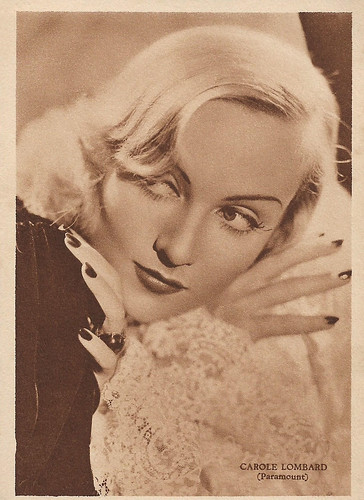
Italian postcard by Rizzoli & C., Milano, 1940. Photo: Paramount.
American film actress Carole Lombard (1908–1942) was the highest-paid Hollywood star in the late 1930s. She was particularly noted for her energetic, ditzy, and often off-beat roles in screwball comedies. In 1939, she starred in Made For Each Other (RKO) and In Name Only (UA), both directed by John Cromwell. The next year, she appeared in RKO's Vigil in the Night (George Stevens, 1940), and They Knew What They Wanted (Garson Kanin, 1940). The beautiful photo on the Rizzoli card must have been made for Paramount's True Confession (Wesley Ruggles, 1937).
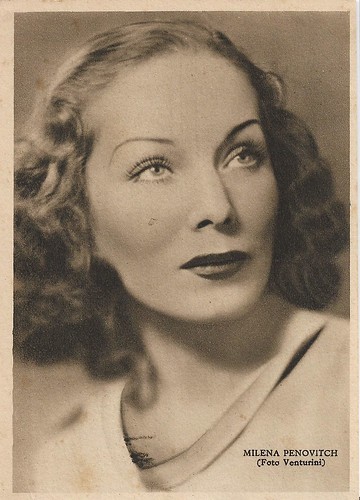
Italian postcard by Rizzoli & C., Milano, 1940. Photo: Venturini.
Milena Penovich (1915-?) was an Italian actress of the 1930s and early 1940s. Born in Trieste, she moved to Rome. In 1939, she was chosen to be the protagonist Frida of the film comedy Equatore (Gino Valori, 1939). Next, in Mario Camerini's Grandi magazzini (1939), starring Vittorio De Sica and Assia Noris. Penovich was the arrogant Anna, part of a gang of department store robbers, led by the staff manager, Bertini (Enrico Glori). After that, Penovich acted in a string of films directed by her husband Piero Ballerini. When the couple also made films in the film studio Cinevillaggio in Venice during the German Occupation and the Repubblica di Salò, they were marginalised after the war, and Penovich left the film world.

Italian postcard by Rizzoli & C., Milano, 1940. Photo: Pesce. Germaine Montero in Il peccato di Rogelia Sanchez/Santa Rogelia (Carlo Borghesio, Roberto de Ribón, 1940).
Germaine Montero (1909-2000) was a French actress, who debuted on stage in Madrid in 1932, performing Lorca. She returned to France in 1938 because of the Civil War and performed in plays by Lorca, Brecht, and Anouilh on the French stage. At the same time, she also started singing traditional Spanish songs. After a small part in 1934, Montero had her breakthrough in the cinema with the Spanish-Italian co-production Il peccato di Rogelia Sanchez/Santa Rogelia (1940). It was shot at Cinecittà in two versions, directed by Carlo Borghesio (Italian version) and Roberto de Ribón (Spanish version). In both versions, Montero and Rafael Rivelles played the leads, while the bad guy was played by Juan De Landa. Montero was advertised in Germany as a Spanish actress.

Italian postcard by Rizzoli & C., Milano, 1940. Photo: Pesce.
Assia Noris (1912-1998) is best remembered as the star of several Italian romantic comedies of the 1930s, directed by Mario Camerini and co-starring Vittorio De Sica. She was married to Camerini between 1940 and 1943. In 1939, she starred in Batticuore/Heartbeat (Mario Camerini, 1939), Grandi magazzini/Department Store (Mario Camerini, 1939) en in a double role in Dora Nelson (Mario Soldati). In 1940 followed Centomila dollari/100.000 Dollars (Mario Camerini, 1940) and Una romantica avventura/A Romantic Adventure (Mario Camerini, 1940).

Italian postcard by Rizzoli & C., Milano, 1940. Photo: Venturini.
Doris Duranti (1917-1995) was a major star of the Italian cinema of the late 1930s and early 1940s, and the main competitor of Clara Calamai. Duranti was also privately the lover a notorious fascist. In 1939, she acted in Cavalleria rusticana (Amleto Palermi, 1939) and Diamanti/Diamonds (Corrado d’Errico, 1939), and in 1940 in Ricchezza senza domani/Wealth without tomorrow (F.M. Poggioli, 1939), È sbarcato un marinaio/A sailor has landed (Piero Balllerini, 1940), and Il cavaliere di Kruja/The Knight of Kruja (Carlo Campogalliani, 1940).
In April 1940, Germany conquered Denmark and Norway. In May 1940, the Nazis started the Blitzkrieg and invaded The Netherlands, Belgium, and the North and West of France. The South-East of France became a ‘Free Zone’ or rather a French puppet government led by Maréchal Philippe Petain.
On 10 June 1940, Italy declared war on France and implicitly on Britain too. It conquered territory of 832 km² in the South of France, centered around Menton.
All the Italian newspapers, controlled by the fascist regime, lauded Italy’s going to war, except for the Vatican paper Osservatore Romano and clandestine papers. The American president Roosevelt considered it a stab in the back to France.
In September 1940, the Italian army invaded Egypt from Libya, planning to connect Libya with the East-African Italian colonies. In October 1940 Italy tried to conquer Greece.
In both cases, the British army and locals held the Italians back. In December 1940 the British did a countermove in Africa, driving the Italians out of Egypt. In early 1941, they would defeat the Italian army in Libya.

Italian postcard by Rizzoli & Co., Milan, 1940. Photo: Caminada.
Elli Parvo (1914–2010) was an Italian screen actress between the mid-1930s and 1960. In 1939, she appeared in Il marchese di Ruvolito/The Marquis of Ruvolo (Raffaello Matarazzo, 1939) and La notte delle beffe/The Night of Tricks (Carlo Campogalliani, 1939). In 1940 followed parts in Ardititi civili (Domenico Gambino, 1940), Miseria e nobiltà/Misery and nobility (Corrado d’Errico, 1940), Il ponte dei sospiri/The bridge of sighs (Mario Bonnard, 1940), and La donna perduta/The lost woman (Domenico Gambino, 1940). She was later known as the woman men fight over in Desiderio/Desire (Marcello Pagliero, 1943-1946) and as the seductress in Il sole sorge ancora/Outcry (Aldo Vergano, 1946). "Gorgeous, dark-haired, luscious-lipped, shapely-legged, not afraid of showing as much of her body as could be, Elli Parvo was THE femme fatale of post-war Italy", according to Guy Bellinger on IMDb.

Italian postcard by Rizzoli & C., Milano, 1940. Photo: Venturini.
Italian actress Laura Nucci (1913-1994) was one of the stars of Italian cinema of the 1930s and 1940s. Between 1930 and 1989, she appeared in more than 60 films and TV series. In 1939, she appeared in 8 (!) films: Eravamo sette vedove/We Were Seven Widows (Mario Mattoli, 1939), La voce senza volto/The faceless voice (Gennaro Righelli, 1939), Belle o brutte si sposan tutte.../Pretty or Plain They All Get Married (Carlo Ludovico Bragaglia, 1939), Diamanti/Diamonds (Corrado D'Errico, 1939), Il cavaliere di San Marco/The Knight of San Marco (Gennaro Righelli, 1939), Il barone di Corbò/The Baron of Corbò (Gennaro Righelli, 1939), Piccolo hotel/Small Hotel (Piero Ballerini, 1939), and La mia canzone al vento/My Song to the Wind (Guido Brignone, 1939). In 1940, she made Cantate con me!/Song of My Heart (Guido Brignone, 1940)

Italian postcard. Rizzoli & C., Milano, 1940. Photo: Houston Rogers.
Italian film and voice actress Clelia Matania (1918–1981) was born in London from Neapolitan parents. She did drama school in London and started to act in her first films by the mid-1930s. When the family moved back to Italy around 1937, she started a rich career in the Italian cinema, debuting with Partire/Departure (Amleto Palermi, 1938) with Vittorio De Sica. Several films with Palermi followed. In 1939 she had her first lead in Papà per una notte/Father for a Night (Mario Bonnard, 1940) starring Sergio Tofano. Her other films that year were Follie del secolo/Follies of the century (Amleto Palermi, 1939), Napoli che non muore/Naples That Never Dies (Amleto Palermi, 1939), and Il socio invisibile/The Invisble Associate (Roberto Roberti, 1939). In 1940, she made no films.

Italian postcard by Rizzoli & Co., Milano, 1940. Photo: New Universal.
When Deanna Durbin's (1921-2013) debut Three Smart Girls (Henry Koster, 1936) was released in 1936 it was an immediate sensation. It was the first of her 21 starring vehicles for Universal. Her films are said to have saved the studio from bankruptcy. In 1939, she starred in Three Smart Girls Grow up and First Love, both directed by Henry Koster.

Italian postcard by Rizzoli & C., Milano, 1940. Photo: London Films.
Indian-born British actress Merle Oberon (1911-1979) had her breakthrough as Anna Boleyn in The Private Life of Henry VIII (Alexander Korda, 1933). She played leading roles in such British films as The Scarlet Pimpernel (Harold Young, 1934) before she travelled to Hollywood to star in such classics as The Dark Angel (Sidney Franklin, 1935) and Wuthering Heights (William Wyler, 1939). In 1939, she also appeared in Over the Moon (Thornton Freeland, 1939), and The Lion Has Wings (Adrian Brunel, 1939), both for London Film Productions. The following year, she starred in 'Til We Meet Again (Edmund Goulding, 1940) for Warner Bros.
The 8th annual Venice International Film Festival was held from September 1 to September 8, 1940, less than three months after Italy had belatedly entered the Second World War as Germany’s ally. Together with the editions of 1941 and 1942, Allied countries considered it as not having happened. Events were held far from the Lido, few counties participated because of the war, so films only came from Italy, Germany, Hungary, and Sweden.
Among the foreign films was the virulent antisemitic film Jud Süss/Jew Süss (Veit Harlan, 1940), starring Ferdinand Marian, Heinrich George, and Kristina Söderbaum, but the winner of the Mussolini Cup for the best foreign film was won by the Pushkin adaptation Der Postmeister (Gustav Ucicky, 1940), starring Heinrich George as the postmaster, Hilde Krahl as his daughter, and Siegfried Breuer as the villain.
Among the competing films for the Mussolini Cup for best Italian film were Abbandono (Mario Mattoli) with Corinne Luchaire, Georges Rigaud and Maria Denis, Don Pasquale (Camillo Mastrocinque) with Armando Falconi, Laura Solari and Greta Gonda, and Il cavaliere di Kruja (Carlo Campogalliani) with Doris Duranti, Antonio Centa and Leda Gloria.
Other titles were La peccatrice (Amleto Palermi) starring Paola Barbara and also with Vittorio De Sica and Gino Cervi, Oltre l’ampre (Carmine Gallone) with Alida Valli and Amedeo Nazzari, and Una romantica avventura (Mario Camerini) starring Assia Noris, Gino Cervi and Leonardo Cortese.
The winner was the propaganda film L’assedio dell’Alcazar/Alcazar (Augusto Genina, 1940), starring Fosco Giachetti and Maria Denis. Set during the Spanish civil war, the story of a commander of a fort Alcazar in Toledo, faithful to General Franco. The film was shot in Cinecittà with Italian, French, and Spanish actors. In the Italian version, all three non-Italian actors (Mireille Balin, Rafael Calvo, and Carlos Muñoz) spoke their lines in Italian. They were dubbed by Italian actors afterwards.

Italian postcard by Rizzoli & C., Milano, 1940. Photo: Radio Pictures.
Canadian-born American actress Fay Wray (1907-2004) attained international recognition as the first 'scream queen' in a series of horror films during the early 1930s. Through an acting career that spanned nearly six decades, Wray is best known as Ann Darrow, the girl held in the hand of King Kong (Merian C. Cooper, Ernest B. Schoedsack, 1933). In 1939, she appeared in the B film Navy Secrets (Howard Bretherton, 1939), and the following year in another B-film Wildcat Bus (Frank Woodruff, 1940). The wonderful glamour portrait on the Rizzoli card was made in the days she was still under contract by RKO, around 1934. Two days after her death, the lights of the Empire State Building, the location of King Kong's climax scene, were dimmed for 15 minutes in memory of the "beauty who charmed the beast".

Italian postcard by Rizzoli & C., Milano, 1940. Photo: Artisti Associati (United Artists).
The career of American actress Loretta Young (1913-2000) peaked between the late 1920s and the early 1950s. She acted in over 100 films. In 1939 she starred in The Story of Alexander Graham Bell (Irving Cummings, 1939), and Eternally Yours (Tay Garnett, 1939). Then she had a hit with The Doctor Takes a Wife (Alexander Hall, 1940), followed by He Stayed for Breakfast (Alexander Hall, 1940). However, none of these films was made for United Artists.
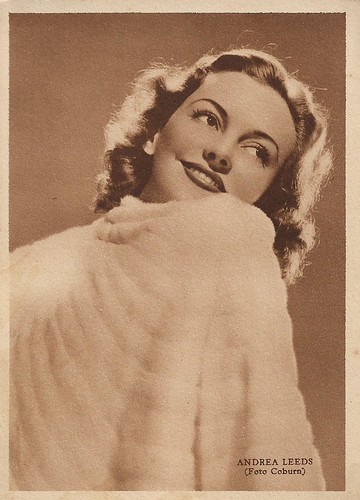
Italian postcard by Rizzoli & C., Milano, 1940. Photo: Coburn.
American film actress Andrea Leeds (1914–1984) was a popular supporting player in the late 1930s. She was nominated for the Oscar for Best Supporting Actress for Stage Door (Gregory La Cava, 1937). She then did two films with Joel McCrea in which she had the female lead: Youth Takes a Fling (Archie Mayo, 1938), and They Shall Have Music (Archie Mayo, 1939). These were followed by more leads in The Real Glory (Henry Hathaway, 1939) with Gary Cooper and Swanee River (Sidney Lanfield, 1939) with Don Ameche. In 1939 she married and quit film acting.
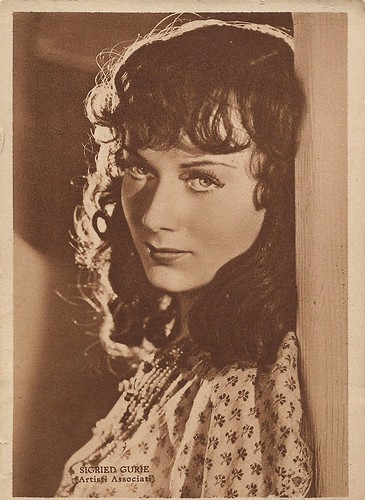
Italian postcard by Rizzoli & C., Milano, 1940. Photo: United Artists. Sigrid Gurie in Algiers (John Cromwell, 1938).
Sigrid Gurie (1911–1969) was a Norwegian American film actress, who was active from the late 1930s to the early 1940s. Her best-known films include Algiers (John Cromwell, 1938), The Adventures of Marco Polo (Archie Mayo, 1938), The Forgotten Woman (Harold Young, 1939), Rio (John Brahm), and Three Faces West (Bernard Vorhaus, 1940) with John Wayne.
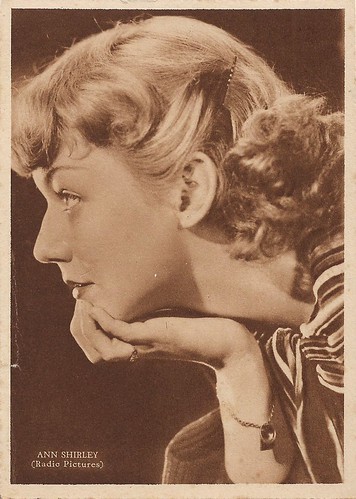
Italian postcard by Rizzoli & C., Milano, 1940. Photo: Radio Pictures (RKO).
American actress Anne Shirley (1918-1993) started as a child actor under the name of Dawn O'Day. She could be seen in Disney's combined live-action and animation shorts around 'Alice' and was a successful child star in Pre-Code movies. In 1934 she starred as Anne Shirley in Anne of the Green Gables (George Nicholls jr., 1934) and henceforth kept that as her own name. She starred in Steamboat 'Round the Bend (John Ford, 1935), Make Way for a Lady (David Burton, 1936), and Stella Dallas (King Vidor, 1937). For the latter, she was nominated for the Oscar for Best Supporting Actress. In the later 1930s, Shirley worked for RKO and starred in Boy Slaves (P.J. Thompson, 1939), Sorority House (John Farrow, 1939), Vigil in the Night (George Stevens, 1939), and Career (Leigh Jason, 1939). Later roles were in Anne of Windy Poplars (Jack Hively, 1940) the sequel to Anne of the Green Gables, The Devil and Daniel Webster (William Dieterle, 1941), and the Film Noir Murder, My Sweet (Edward Dmytryk, 1944), her final film.
Prominent Italian films of 1940 were Addio, giovinezza!/Goodbye, Youth (Fernando Maria Poggioli, 1940) with Maria Denis and Adriano Rimoldi, Senza cielo/Without the Sky (Alfredo Guarini, 1940) with Isa Miranda, and La fanciulla di Portici/The girl of Portici (Mario Bonnard, 1940) with Luisa Ferida.
There were historical films like Manon Lescaut (Carmine Gallone, 1940) with Alida Valli and Vittorio De Sica, Kean (Guido Brignone) starring Rossano Brazzi, and Lucrezia Borgia (Hans Hinrich, 1940) with Isa Pola in the title role. Other interesting films were Dopo divorzieremo/Then We’ll get a Divorce (Nunzio Malasomma, 1940) with Vivi Gioi and Amedeo Nazzari, and Il ponte di vetro/Bridge of Glass (Goffredo Alessandrini, 1940) with Isa Pola and Rossano Brazzi.
In particular, Alida Valli and Maria Denis were highly active as an actress in 1940, each played in 5 to 6 films. French and Spanish actors remained active in the Italian cinema. Conchita Montenegro acted opposite Armando Falconi in La nascita di Salomé (Jean Choux, 1940) and opposite Gino Cervi as Mozart in the musical biopic Melodie eterne/Eternal Melodies (Carmine Gallone, 1940).
Released early 1940 by Scalera was the film Ecco la felicità, also filmed in French version as La Comédie du bonheur, by Marcel L’Herbier, and with the main cast consisting of French actors such as Michel Simon, Micheline Presle, Jacqueline Delubac, and Louis Jordan, plus the former hero of Ben-Hur: A Tale of the Christ (Fred Niblo, 1925): Ramon Novarro.
Vittorio De Sica, highly active as an actor in 1940, also debuted as a film director: first with Rose scarlatte/Red Roses (Vittorio De Sica, Giuseppe Amato, 1940) with French actress Renée St. Cyr and De Sica himself in the leads, followed by Maddalena, zero in condotta (Vittorio De Sica, 1940) with a debuting Carla Del Poggio and De Sica himself. In the latter film also other upcoming young actresses appeared such as Irasema Dilian and Luisella Beghi.
According to national box office figures, the most successful Italian film within Italy in 1940 (cashing 9 million lire) was the period piece Il ponte dei sospiri/The bridge of sighs by Mario Bonnard, set in 16th century Venice, and starring Otello Toso as Doge’s son Rolando Candiano, Mariella Lotti as his beloved Eleonora, Paola Barbara as the vengeful Imperia, and Erminio Spalla as robust and good-hearted robber Scalabrino.
Despite the fallback in early 1939 because of the Hollywood majors backing out of Italy and the number of American films drastically going down, American films remained in favour with Italian audiences, even after Italy went to war. The US was neutral at the start of the Second World War. Until June 1940, German cinema was much less in favour by Italian audiences than American, French, or even British films. The Italians rather preferred Deanna Durbin, Michele Morgan, or George Formby.
When war broke out, the British cinema fell away of course, but after Italian cinema, Hollywood and French cinema came in places 2 and 3 in the favour of the Italian cinema spectators. Though an official contract of the Italian state with the Majors failed, in 1940 Italy still imported 80 American films, versus 46 French, 40 German, and 16 British ones.

Italian postcard by Rizzoli & C., Milano, 1940. Photo: M.G.M. As MGM withdrew from the Italian market in January 1939 it is remarkable that Rizzoli used a card with an MGM star in 1940. On the other hand, many Rizzoli cards refer to stars who were in the spotlights earlier.
Virginia Bruce (1909-1982) was an American leading lady of the 1930s and 1940s. Her blond good looks got her an entry into films, and a contract at MGM in 1932. By 1937 she became a first-billing film star in a string of MGM films with actors such as Fredric March, Melvyn Douglas, and Walter Pidgeon. In 1939 she starred with Nelson Eddy in Let Freedom Ring (Jack Conway, 1939), with Walter Pidgeon in Society Lawyer (Edwin L. Marin, 1939, and again with Pidgeon in Stronger Than Desire (Leslie Fenton, 1939). After her seven-year-contract with MGM expired in 1939, she started to work for various companies, first Warner and Universal, then also Columbia, 20th Century Fox, and Republic. In 1942, when her son Christopher was born, her career stopped and it only slightly retook from 1944. In the 1950s she could be seen in various TV series.

Italian postcard by Rizzoli & C., Milano, 1940. Photo: Fox.
Simone Simon (1910-2005) was one of the most seductive and brilliant stars of the French cinema of the 1930s and 1950s. In 1936-1937 and during the war years she worked in Hollywood. Publicity dubbed her ‘La Sauvage Tendre’ (The Tender Savage). For Fox, she starred in such films as Seventh Heaven (Henry King, 1937) with James Stewart.

Italian postcard by Rizzoli & C., Milano, 1940. Photo: ACE.
Mireille Balin (1909-1968) was the most beautiful woman in the French cinema of the 1930s. The glamorous actress is best known as the femme fatale who lured Jean Gabin into his downfall in the classics Pépé le Moko (Julien Duvivier, 1936) and Gueule d'amour/Lady Killer (Jean Gremillon, 1937). In 1939, she played in such films as Terra di fuoco/Land of fire (Giorgio Ferroni, Marcel L’Herbier, 1939), shot in Italy. The following year, she made in Italy 1940: L’assedio dell’Alcazar/The Siege of the Alcazar (Augusto Genina, 1940). After the war, her love affair with a Wehrmacht officer led to the end of her career and Balin died poor and forgotten.
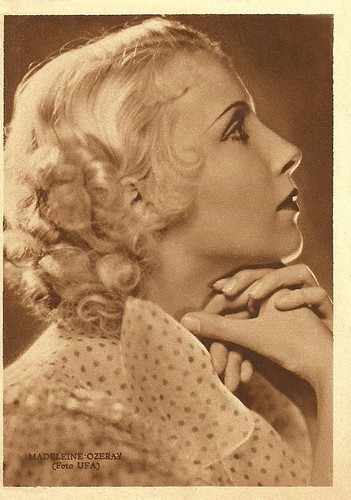
Italian postcard by Rizzoli & C, Milano, 1940. Photo: Ufa.
Franco-Belgian stage and film actress Madeleine Ozeray (1908-1989) appeared in many films between 1932 and 1980. In 1938 she played the waitress Jeannette in La fin du jour/The End of the day (Julien Duvivier, 1939) which was presented that year at Venice International Film Festival. In 1939-1940, she only acted on stage. She was cast in the film L'école des femmes/The School of Women (Max Ophüls, 1940) but the film was never finished after actor Louis Jouvet left the production.
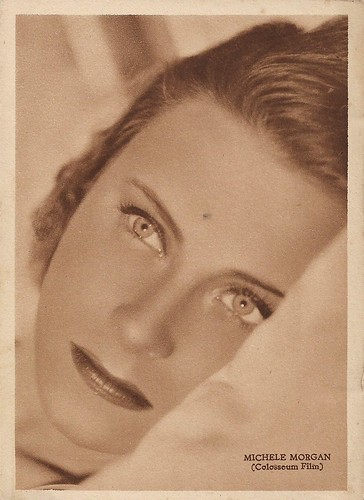
Italian postcard by Rizzoli & C., Milano, 1940. Photo: Colosseum Film.
Blonde French actress Michèle Morgan (1920-2016) was a classic beauty. She has been one of her country's most popular leading ladies for over five decades. The delicate, sophisticated and detached star was especially noted for her large, expressive eyes. In 1939 she starred in Le Récif de corail/Coral Reefs (Maurice Gleize, 1939), and Les Musiciens du ciel/The musicians of the sky (Georges Lacombe, 1939), and the following year in Remorques/Stormy Waters (Jean Grémillon, 1940), and Untel père et fils/Immortal France (Julien Duvivier, 1940).
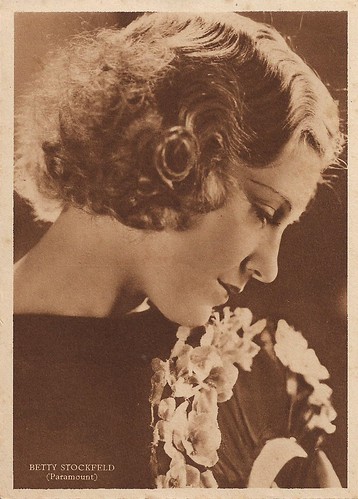
Italian postcard by Rizzoli & C., Milano, 1940. Photo: Paramount.
Betty Stockfeld (1904–1966), her name often misspelled as Stockfield, was an Australian film actress, who appeared mostly in British and French films. In 1939 she acted in one Italian film: Frenesia/Frenzy (Mario Bonnard, 1939), starring the two old monstres sacré of the Italian stage, Dina Galli and Antonio Gandusio. In the same year, she also acted in Les neuf célibataires/Nine Bachelors (Sacha Guitry, 1939), Son oncle de Normandie/His uncle from Normandy(Jean Dréville, 1939), Derrière la façade/Double entendre (Georges Lacombe, Yves Mirande, 1939), and Les gangsters du château d'If/The gangsters of Château d'If (René Pujol, 1939). In 1940 she still did three films in France before the war broke out. Yet, despite the indication on the postcard of Paramount, Stockfeld made no film for Paramount in 1939-1940, neither as a production company nor as a distribution company.
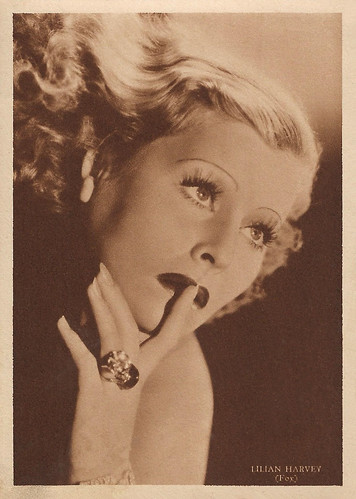
Italian postcard by Rizzoli & C., Milano, 1940. Photo: Fox.
British born, German actress and singer Lilian Harvey (1906-1968) was Ufa's biggest star of the 1930s. With Willy Fritsch, she formed the 'Dream Team of the European Cinema'. Their best film was the immensely popular film operetta Der Kongress tanzt/The Congress Dances (Erik Charell, 1931). The international success of the film led Harvey to Hollywood. Between 1933 and 1935, she made films for Fox and Columbia. In 1939, she starred in the Italian film Castelli in aria/Castles in the Air (Augusto Genina, 1939) with Vittorio De Sica, and also in the German version, Ins blaue Leben. In 1940 she made her last films, the French productions Sérénade/Schubert’s Serenade (Jean Boyer, 1940) with Louis Jouvet, and the comedy Miquette (Jean Boyer, 1940).
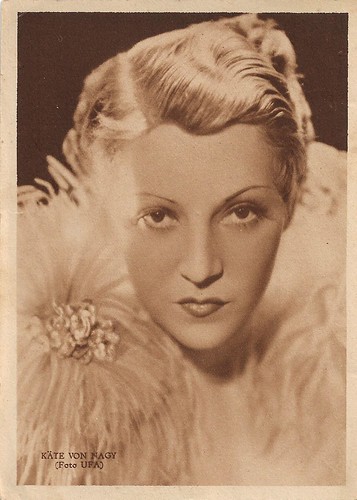
Italian postcard by Rizzoli & C., Milano, 1940. Photo: UFA.
Hungarian actress Käthe von Nagy (1904-1973) started as the ‘Backfish’ of German films of the late 1920s. In the early 1930s, she became a fashionable and charming star of the German and French cinema. In 1939 she appeared in Salonwagen E 417/Luxury Train (Paul Verhoeven, 1939) and Renate im Quartett/Renate in the Quartet (Paul Verhoeven, 1939). However, the Ufa portrait of the postcard must have been made earlier.
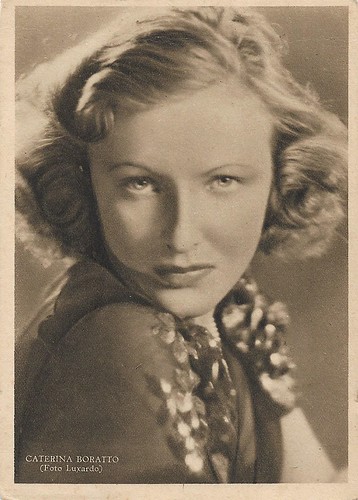
Italian postcard by Rizzoli & C., Milano, 1940. Photo: Luxardo.
Caterina Boratto (1915-2010) was an Italian film actress, who appeared in 50 films between 1936 and 1993. Noted by director Guido Brignone, she made her debut in his Vivere/To Live, alongside Tito Schipa, who fell in love with her. Thanks to the film's success, she immediately became a star in the Telefoni Bianchi genre. In the comedy Hanno rapito un uomo/They've Kidnapped a Man (Gennaro Righelli, 1938) she played a Russian grand duchess opposite Vittorio De Sica as a film actor. Metro-Goldwyn-Mayer offered her a seven-year contract and she moved to Hollywood to become a second Jeanette MacDonald, but tired of waiting to start the first film she returned to Italy just when World War II broke out. During the war, she fell in love with a war hero, count Guidi di Romena, who was killed in an air fight, against the background of Turin being bombed.

Italian postcard by Rizzoli & C., Milano, 1940. Photo: Pesce.
Pert, French star Jacqueline Delubac (1907-1997) was the third wife of actor, dramatist and film director Sacha Guitry. She starred in eleven of Guitry’s feathery comedies in which her husband co-starred. Between the two wars, the charming actress was one of the most seductive stars of the French cinema. Life magazine rated her as one of the five most elegant women in the world. In 1939 Delubac acted in the French and Italian versions of Ultima giovinezza/Dernière jeunesse (Fred Musso, 1939), shot at the Scalera Studios in Rome. In 1940 she acted in Ecco la felicità/La comédie du bonheur/The Comedy of Happiness (1940), also shot in two versions at Scalera, by French director Marcel L'Herbier. Pesce may have shot this photo then. These were her only Italian films in those years.
To be continued. Also check out Part 1, Part 2, Part 3, and Part 4.
Sources: Francesco Bono (Storia del cinema Italiano 1940-1944), Wikipedia (Italian, French, German and English) and IMDb.

Italian postcard by Rizzoli & C., Milano, 1940. Photo: Paramount.
American film actress Carole Lombard (1908–1942) was the highest-paid Hollywood star in the late 1930s. She was particularly noted for her energetic, ditzy, and often off-beat roles in screwball comedies. In 1939, she starred in Made For Each Other (RKO) and In Name Only (UA), both directed by John Cromwell. The next year, she appeared in RKO's Vigil in the Night (George Stevens, 1940), and They Knew What They Wanted (Garson Kanin, 1940). The beautiful photo on the Rizzoli card must have been made for Paramount's True Confession (Wesley Ruggles, 1937).

Italian postcard by Rizzoli & C., Milano, 1940. Photo: Venturini.
Milena Penovich (1915-?) was an Italian actress of the 1930s and early 1940s. Born in Trieste, she moved to Rome. In 1939, she was chosen to be the protagonist Frida of the film comedy Equatore (Gino Valori, 1939). Next, in Mario Camerini's Grandi magazzini (1939), starring Vittorio De Sica and Assia Noris. Penovich was the arrogant Anna, part of a gang of department store robbers, led by the staff manager, Bertini (Enrico Glori). After that, Penovich acted in a string of films directed by her husband Piero Ballerini. When the couple also made films in the film studio Cinevillaggio in Venice during the German Occupation and the Repubblica di Salò, they were marginalised after the war, and Penovich left the film world.

Italian postcard by Rizzoli & C., Milano, 1940. Photo: Pesce. Germaine Montero in Il peccato di Rogelia Sanchez/Santa Rogelia (Carlo Borghesio, Roberto de Ribón, 1940).
Germaine Montero (1909-2000) was a French actress, who debuted on stage in Madrid in 1932, performing Lorca. She returned to France in 1938 because of the Civil War and performed in plays by Lorca, Brecht, and Anouilh on the French stage. At the same time, she also started singing traditional Spanish songs. After a small part in 1934, Montero had her breakthrough in the cinema with the Spanish-Italian co-production Il peccato di Rogelia Sanchez/Santa Rogelia (1940). It was shot at Cinecittà in two versions, directed by Carlo Borghesio (Italian version) and Roberto de Ribón (Spanish version). In both versions, Montero and Rafael Rivelles played the leads, while the bad guy was played by Juan De Landa. Montero was advertised in Germany as a Spanish actress.

Italian postcard by Rizzoli & C., Milano, 1940. Photo: Pesce.
Assia Noris (1912-1998) is best remembered as the star of several Italian romantic comedies of the 1930s, directed by Mario Camerini and co-starring Vittorio De Sica. She was married to Camerini between 1940 and 1943. In 1939, she starred in Batticuore/Heartbeat (Mario Camerini, 1939), Grandi magazzini/Department Store (Mario Camerini, 1939) en in a double role in Dora Nelson (Mario Soldati). In 1940 followed Centomila dollari/100.000 Dollars (Mario Camerini, 1940) and Una romantica avventura/A Romantic Adventure (Mario Camerini, 1940).

Italian postcard by Rizzoli & C., Milano, 1940. Photo: Venturini.
Doris Duranti (1917-1995) was a major star of the Italian cinema of the late 1930s and early 1940s, and the main competitor of Clara Calamai. Duranti was also privately the lover a notorious fascist. In 1939, she acted in Cavalleria rusticana (Amleto Palermi, 1939) and Diamanti/Diamonds (Corrado d’Errico, 1939), and in 1940 in Ricchezza senza domani/Wealth without tomorrow (F.M. Poggioli, 1939), È sbarcato un marinaio/A sailor has landed (Piero Balllerini, 1940), and Il cavaliere di Kruja/The Knight of Kruja (Carlo Campogalliani, 1940).
War in Europe
In April 1940, Germany conquered Denmark and Norway. In May 1940, the Nazis started the Blitzkrieg and invaded The Netherlands, Belgium, and the North and West of France. The South-East of France became a ‘Free Zone’ or rather a French puppet government led by Maréchal Philippe Petain.
On 10 June 1940, Italy declared war on France and implicitly on Britain too. It conquered territory of 832 km² in the South of France, centered around Menton.
All the Italian newspapers, controlled by the fascist regime, lauded Italy’s going to war, except for the Vatican paper Osservatore Romano and clandestine papers. The American president Roosevelt considered it a stab in the back to France.
In September 1940, the Italian army invaded Egypt from Libya, planning to connect Libya with the East-African Italian colonies. In October 1940 Italy tried to conquer Greece.
In both cases, the British army and locals held the Italians back. In December 1940 the British did a countermove in Africa, driving the Italians out of Egypt. In early 1941, they would defeat the Italian army in Libya.

Italian postcard by Rizzoli & Co., Milan, 1940. Photo: Caminada.
Elli Parvo (1914–2010) was an Italian screen actress between the mid-1930s and 1960. In 1939, she appeared in Il marchese di Ruvolito/The Marquis of Ruvolo (Raffaello Matarazzo, 1939) and La notte delle beffe/The Night of Tricks (Carlo Campogalliani, 1939). In 1940 followed parts in Ardititi civili (Domenico Gambino, 1940), Miseria e nobiltà/Misery and nobility (Corrado d’Errico, 1940), Il ponte dei sospiri/The bridge of sighs (Mario Bonnard, 1940), and La donna perduta/The lost woman (Domenico Gambino, 1940). She was later known as the woman men fight over in Desiderio/Desire (Marcello Pagliero, 1943-1946) and as the seductress in Il sole sorge ancora/Outcry (Aldo Vergano, 1946). "Gorgeous, dark-haired, luscious-lipped, shapely-legged, not afraid of showing as much of her body as could be, Elli Parvo was THE femme fatale of post-war Italy", according to Guy Bellinger on IMDb.

Italian postcard by Rizzoli & C., Milano, 1940. Photo: Venturini.
Italian actress Laura Nucci (1913-1994) was one of the stars of Italian cinema of the 1930s and 1940s. Between 1930 and 1989, she appeared in more than 60 films and TV series. In 1939, she appeared in 8 (!) films: Eravamo sette vedove/We Were Seven Widows (Mario Mattoli, 1939), La voce senza volto/The faceless voice (Gennaro Righelli, 1939), Belle o brutte si sposan tutte.../Pretty or Plain They All Get Married (Carlo Ludovico Bragaglia, 1939), Diamanti/Diamonds (Corrado D'Errico, 1939), Il cavaliere di San Marco/The Knight of San Marco (Gennaro Righelli, 1939), Il barone di Corbò/The Baron of Corbò (Gennaro Righelli, 1939), Piccolo hotel/Small Hotel (Piero Ballerini, 1939), and La mia canzone al vento/My Song to the Wind (Guido Brignone, 1939). In 1940, she made Cantate con me!/Song of My Heart (Guido Brignone, 1940)

Italian postcard. Rizzoli & C., Milano, 1940. Photo: Houston Rogers.
Italian film and voice actress Clelia Matania (1918–1981) was born in London from Neapolitan parents. She did drama school in London and started to act in her first films by the mid-1930s. When the family moved back to Italy around 1937, she started a rich career in the Italian cinema, debuting with Partire/Departure (Amleto Palermi, 1938) with Vittorio De Sica. Several films with Palermi followed. In 1939 she had her first lead in Papà per una notte/Father for a Night (Mario Bonnard, 1940) starring Sergio Tofano. Her other films that year were Follie del secolo/Follies of the century (Amleto Palermi, 1939), Napoli che non muore/Naples That Never Dies (Amleto Palermi, 1939), and Il socio invisibile/The Invisble Associate (Roberto Roberti, 1939). In 1940, she made no films.

Italian postcard by Rizzoli & Co., Milano, 1940. Photo: New Universal.
When Deanna Durbin's (1921-2013) debut Three Smart Girls (Henry Koster, 1936) was released in 1936 it was an immediate sensation. It was the first of her 21 starring vehicles for Universal. Her films are said to have saved the studio from bankruptcy. In 1939, she starred in Three Smart Girls Grow up and First Love, both directed by Henry Koster.

Italian postcard by Rizzoli & C., Milano, 1940. Photo: London Films.
Indian-born British actress Merle Oberon (1911-1979) had her breakthrough as Anna Boleyn in The Private Life of Henry VIII (Alexander Korda, 1933). She played leading roles in such British films as The Scarlet Pimpernel (Harold Young, 1934) before she travelled to Hollywood to star in such classics as The Dark Angel (Sidney Franklin, 1935) and Wuthering Heights (William Wyler, 1939). In 1939, she also appeared in Over the Moon (Thornton Freeland, 1939), and The Lion Has Wings (Adrian Brunel, 1939), both for London Film Productions. The following year, she starred in 'Til We Meet Again (Edmund Goulding, 1940) for Warner Bros.
A Festival considered as not having happened
The 8th annual Venice International Film Festival was held from September 1 to September 8, 1940, less than three months after Italy had belatedly entered the Second World War as Germany’s ally. Together with the editions of 1941 and 1942, Allied countries considered it as not having happened. Events were held far from the Lido, few counties participated because of the war, so films only came from Italy, Germany, Hungary, and Sweden.
Among the foreign films was the virulent antisemitic film Jud Süss/Jew Süss (Veit Harlan, 1940), starring Ferdinand Marian, Heinrich George, and Kristina Söderbaum, but the winner of the Mussolini Cup for the best foreign film was won by the Pushkin adaptation Der Postmeister (Gustav Ucicky, 1940), starring Heinrich George as the postmaster, Hilde Krahl as his daughter, and Siegfried Breuer as the villain.
Among the competing films for the Mussolini Cup for best Italian film were Abbandono (Mario Mattoli) with Corinne Luchaire, Georges Rigaud and Maria Denis, Don Pasquale (Camillo Mastrocinque) with Armando Falconi, Laura Solari and Greta Gonda, and Il cavaliere di Kruja (Carlo Campogalliani) with Doris Duranti, Antonio Centa and Leda Gloria.
Other titles were La peccatrice (Amleto Palermi) starring Paola Barbara and also with Vittorio De Sica and Gino Cervi, Oltre l’ampre (Carmine Gallone) with Alida Valli and Amedeo Nazzari, and Una romantica avventura (Mario Camerini) starring Assia Noris, Gino Cervi and Leonardo Cortese.
The winner was the propaganda film L’assedio dell’Alcazar/Alcazar (Augusto Genina, 1940), starring Fosco Giachetti and Maria Denis. Set during the Spanish civil war, the story of a commander of a fort Alcazar in Toledo, faithful to General Franco. The film was shot in Cinecittà with Italian, French, and Spanish actors. In the Italian version, all three non-Italian actors (Mireille Balin, Rafael Calvo, and Carlos Muñoz) spoke their lines in Italian. They were dubbed by Italian actors afterwards.

Italian postcard by Rizzoli & C., Milano, 1940. Photo: Radio Pictures.
Canadian-born American actress Fay Wray (1907-2004) attained international recognition as the first 'scream queen' in a series of horror films during the early 1930s. Through an acting career that spanned nearly six decades, Wray is best known as Ann Darrow, the girl held in the hand of King Kong (Merian C. Cooper, Ernest B. Schoedsack, 1933). In 1939, she appeared in the B film Navy Secrets (Howard Bretherton, 1939), and the following year in another B-film Wildcat Bus (Frank Woodruff, 1940). The wonderful glamour portrait on the Rizzoli card was made in the days she was still under contract by RKO, around 1934. Two days after her death, the lights of the Empire State Building, the location of King Kong's climax scene, were dimmed for 15 minutes in memory of the "beauty who charmed the beast".

Italian postcard by Rizzoli & C., Milano, 1940. Photo: Artisti Associati (United Artists).
The career of American actress Loretta Young (1913-2000) peaked between the late 1920s and the early 1950s. She acted in over 100 films. In 1939 she starred in The Story of Alexander Graham Bell (Irving Cummings, 1939), and Eternally Yours (Tay Garnett, 1939). Then she had a hit with The Doctor Takes a Wife (Alexander Hall, 1940), followed by He Stayed for Breakfast (Alexander Hall, 1940). However, none of these films was made for United Artists.

Italian postcard by Rizzoli & C., Milano, 1940. Photo: Coburn.
American film actress Andrea Leeds (1914–1984) was a popular supporting player in the late 1930s. She was nominated for the Oscar for Best Supporting Actress for Stage Door (Gregory La Cava, 1937). She then did two films with Joel McCrea in which she had the female lead: Youth Takes a Fling (Archie Mayo, 1938), and They Shall Have Music (Archie Mayo, 1939). These were followed by more leads in The Real Glory (Henry Hathaway, 1939) with Gary Cooper and Swanee River (Sidney Lanfield, 1939) with Don Ameche. In 1939 she married and quit film acting.

Italian postcard by Rizzoli & C., Milano, 1940. Photo: United Artists. Sigrid Gurie in Algiers (John Cromwell, 1938).
Sigrid Gurie (1911–1969) was a Norwegian American film actress, who was active from the late 1930s to the early 1940s. Her best-known films include Algiers (John Cromwell, 1938), The Adventures of Marco Polo (Archie Mayo, 1938), The Forgotten Woman (Harold Young, 1939), Rio (John Brahm), and Three Faces West (Bernard Vorhaus, 1940) with John Wayne.

Italian postcard by Rizzoli & C., Milano, 1940. Photo: Radio Pictures (RKO).
American actress Anne Shirley (1918-1993) started as a child actor under the name of Dawn O'Day. She could be seen in Disney's combined live-action and animation shorts around 'Alice' and was a successful child star in Pre-Code movies. In 1934 she starred as Anne Shirley in Anne of the Green Gables (George Nicholls jr., 1934) and henceforth kept that as her own name. She starred in Steamboat 'Round the Bend (John Ford, 1935), Make Way for a Lady (David Burton, 1936), and Stella Dallas (King Vidor, 1937). For the latter, she was nominated for the Oscar for Best Supporting Actress. In the later 1930s, Shirley worked for RKO and starred in Boy Slaves (P.J. Thompson, 1939), Sorority House (John Farrow, 1939), Vigil in the Night (George Stevens, 1939), and Career (Leigh Jason, 1939). Later roles were in Anne of Windy Poplars (Jack Hively, 1940) the sequel to Anne of the Green Gables, The Devil and Daniel Webster (William Dieterle, 1941), and the Film Noir Murder, My Sweet (Edward Dmytryk, 1944), her final film.
The most successful Italian film in 1940
Prominent Italian films of 1940 were Addio, giovinezza!/Goodbye, Youth (Fernando Maria Poggioli, 1940) with Maria Denis and Adriano Rimoldi, Senza cielo/Without the Sky (Alfredo Guarini, 1940) with Isa Miranda, and La fanciulla di Portici/The girl of Portici (Mario Bonnard, 1940) with Luisa Ferida.
There were historical films like Manon Lescaut (Carmine Gallone, 1940) with Alida Valli and Vittorio De Sica, Kean (Guido Brignone) starring Rossano Brazzi, and Lucrezia Borgia (Hans Hinrich, 1940) with Isa Pola in the title role. Other interesting films were Dopo divorzieremo/Then We’ll get a Divorce (Nunzio Malasomma, 1940) with Vivi Gioi and Amedeo Nazzari, and Il ponte di vetro/Bridge of Glass (Goffredo Alessandrini, 1940) with Isa Pola and Rossano Brazzi.
In particular, Alida Valli and Maria Denis were highly active as an actress in 1940, each played in 5 to 6 films. French and Spanish actors remained active in the Italian cinema. Conchita Montenegro acted opposite Armando Falconi in La nascita di Salomé (Jean Choux, 1940) and opposite Gino Cervi as Mozart in the musical biopic Melodie eterne/Eternal Melodies (Carmine Gallone, 1940).
Released early 1940 by Scalera was the film Ecco la felicità, also filmed in French version as La Comédie du bonheur, by Marcel L’Herbier, and with the main cast consisting of French actors such as Michel Simon, Micheline Presle, Jacqueline Delubac, and Louis Jordan, plus the former hero of Ben-Hur: A Tale of the Christ (Fred Niblo, 1925): Ramon Novarro.
Vittorio De Sica, highly active as an actor in 1940, also debuted as a film director: first with Rose scarlatte/Red Roses (Vittorio De Sica, Giuseppe Amato, 1940) with French actress Renée St. Cyr and De Sica himself in the leads, followed by Maddalena, zero in condotta (Vittorio De Sica, 1940) with a debuting Carla Del Poggio and De Sica himself. In the latter film also other upcoming young actresses appeared such as Irasema Dilian and Luisella Beghi.
According to national box office figures, the most successful Italian film within Italy in 1940 (cashing 9 million lire) was the period piece Il ponte dei sospiri/The bridge of sighs by Mario Bonnard, set in 16th century Venice, and starring Otello Toso as Doge’s son Rolando Candiano, Mariella Lotti as his beloved Eleonora, Paola Barbara as the vengeful Imperia, and Erminio Spalla as robust and good-hearted robber Scalabrino.
Despite the fallback in early 1939 because of the Hollywood majors backing out of Italy and the number of American films drastically going down, American films remained in favour with Italian audiences, even after Italy went to war. The US was neutral at the start of the Second World War. Until June 1940, German cinema was much less in favour by Italian audiences than American, French, or even British films. The Italians rather preferred Deanna Durbin, Michele Morgan, or George Formby.
When war broke out, the British cinema fell away of course, but after Italian cinema, Hollywood and French cinema came in places 2 and 3 in the favour of the Italian cinema spectators. Though an official contract of the Italian state with the Majors failed, in 1940 Italy still imported 80 American films, versus 46 French, 40 German, and 16 British ones.

Italian postcard by Rizzoli & C., Milano, 1940. Photo: M.G.M. As MGM withdrew from the Italian market in January 1939 it is remarkable that Rizzoli used a card with an MGM star in 1940. On the other hand, many Rizzoli cards refer to stars who were in the spotlights earlier.
Virginia Bruce (1909-1982) was an American leading lady of the 1930s and 1940s. Her blond good looks got her an entry into films, and a contract at MGM in 1932. By 1937 she became a first-billing film star in a string of MGM films with actors such as Fredric March, Melvyn Douglas, and Walter Pidgeon. In 1939 she starred with Nelson Eddy in Let Freedom Ring (Jack Conway, 1939), with Walter Pidgeon in Society Lawyer (Edwin L. Marin, 1939, and again with Pidgeon in Stronger Than Desire (Leslie Fenton, 1939). After her seven-year-contract with MGM expired in 1939, she started to work for various companies, first Warner and Universal, then also Columbia, 20th Century Fox, and Republic. In 1942, when her son Christopher was born, her career stopped and it only slightly retook from 1944. In the 1950s she could be seen in various TV series.

Italian postcard by Rizzoli & C., Milano, 1940. Photo: Fox.
Simone Simon (1910-2005) was one of the most seductive and brilliant stars of the French cinema of the 1930s and 1950s. In 1936-1937 and during the war years she worked in Hollywood. Publicity dubbed her ‘La Sauvage Tendre’ (The Tender Savage). For Fox, she starred in such films as Seventh Heaven (Henry King, 1937) with James Stewart.

Italian postcard by Rizzoli & C., Milano, 1940. Photo: ACE.
Mireille Balin (1909-1968) was the most beautiful woman in the French cinema of the 1930s. The glamorous actress is best known as the femme fatale who lured Jean Gabin into his downfall in the classics Pépé le Moko (Julien Duvivier, 1936) and Gueule d'amour/Lady Killer (Jean Gremillon, 1937). In 1939, she played in such films as Terra di fuoco/Land of fire (Giorgio Ferroni, Marcel L’Herbier, 1939), shot in Italy. The following year, she made in Italy 1940: L’assedio dell’Alcazar/The Siege of the Alcazar (Augusto Genina, 1940). After the war, her love affair with a Wehrmacht officer led to the end of her career and Balin died poor and forgotten.

Italian postcard by Rizzoli & C, Milano, 1940. Photo: Ufa.
Franco-Belgian stage and film actress Madeleine Ozeray (1908-1989) appeared in many films between 1932 and 1980. In 1938 she played the waitress Jeannette in La fin du jour/The End of the day (Julien Duvivier, 1939) which was presented that year at Venice International Film Festival. In 1939-1940, she only acted on stage. She was cast in the film L'école des femmes/The School of Women (Max Ophüls, 1940) but the film was never finished after actor Louis Jouvet left the production.

Italian postcard by Rizzoli & C., Milano, 1940. Photo: Colosseum Film.
Blonde French actress Michèle Morgan (1920-2016) was a classic beauty. She has been one of her country's most popular leading ladies for over five decades. The delicate, sophisticated and detached star was especially noted for her large, expressive eyes. In 1939 she starred in Le Récif de corail/Coral Reefs (Maurice Gleize, 1939), and Les Musiciens du ciel/The musicians of the sky (Georges Lacombe, 1939), and the following year in Remorques/Stormy Waters (Jean Grémillon, 1940), and Untel père et fils/Immortal France (Julien Duvivier, 1940).

Italian postcard by Rizzoli & C., Milano, 1940. Photo: Paramount.
Betty Stockfeld (1904–1966), her name often misspelled as Stockfield, was an Australian film actress, who appeared mostly in British and French films. In 1939 she acted in one Italian film: Frenesia/Frenzy (Mario Bonnard, 1939), starring the two old monstres sacré of the Italian stage, Dina Galli and Antonio Gandusio. In the same year, she also acted in Les neuf célibataires/Nine Bachelors (Sacha Guitry, 1939), Son oncle de Normandie/His uncle from Normandy(Jean Dréville, 1939), Derrière la façade/Double entendre (Georges Lacombe, Yves Mirande, 1939), and Les gangsters du château d'If/The gangsters of Château d'If (René Pujol, 1939). In 1940 she still did three films in France before the war broke out. Yet, despite the indication on the postcard of Paramount, Stockfeld made no film for Paramount in 1939-1940, neither as a production company nor as a distribution company.

Italian postcard by Rizzoli & C., Milano, 1940. Photo: Fox.
British born, German actress and singer Lilian Harvey (1906-1968) was Ufa's biggest star of the 1930s. With Willy Fritsch, she formed the 'Dream Team of the European Cinema'. Their best film was the immensely popular film operetta Der Kongress tanzt/The Congress Dances (Erik Charell, 1931). The international success of the film led Harvey to Hollywood. Between 1933 and 1935, she made films for Fox and Columbia. In 1939, she starred in the Italian film Castelli in aria/Castles in the Air (Augusto Genina, 1939) with Vittorio De Sica, and also in the German version, Ins blaue Leben. In 1940 she made her last films, the French productions Sérénade/Schubert’s Serenade (Jean Boyer, 1940) with Louis Jouvet, and the comedy Miquette (Jean Boyer, 1940).

Italian postcard by Rizzoli & C., Milano, 1940. Photo: UFA.
Hungarian actress Käthe von Nagy (1904-1973) started as the ‘Backfish’ of German films of the late 1920s. In the early 1930s, she became a fashionable and charming star of the German and French cinema. In 1939 she appeared in Salonwagen E 417/Luxury Train (Paul Verhoeven, 1939) and Renate im Quartett/Renate in the Quartet (Paul Verhoeven, 1939). However, the Ufa portrait of the postcard must have been made earlier.

Italian postcard by Rizzoli & C., Milano, 1940. Photo: Luxardo.
Caterina Boratto (1915-2010) was an Italian film actress, who appeared in 50 films between 1936 and 1993. Noted by director Guido Brignone, she made her debut in his Vivere/To Live, alongside Tito Schipa, who fell in love with her. Thanks to the film's success, she immediately became a star in the Telefoni Bianchi genre. In the comedy Hanno rapito un uomo/They've Kidnapped a Man (Gennaro Righelli, 1938) she played a Russian grand duchess opposite Vittorio De Sica as a film actor. Metro-Goldwyn-Mayer offered her a seven-year contract and she moved to Hollywood to become a second Jeanette MacDonald, but tired of waiting to start the first film she returned to Italy just when World War II broke out. During the war, she fell in love with a war hero, count Guidi di Romena, who was killed in an air fight, against the background of Turin being bombed.

Italian postcard by Rizzoli & C., Milano, 1940. Photo: Pesce.
Pert, French star Jacqueline Delubac (1907-1997) was the third wife of actor, dramatist and film director Sacha Guitry. She starred in eleven of Guitry’s feathery comedies in which her husband co-starred. Between the two wars, the charming actress was one of the most seductive stars of the French cinema. Life magazine rated her as one of the five most elegant women in the world. In 1939 Delubac acted in the French and Italian versions of Ultima giovinezza/Dernière jeunesse (Fred Musso, 1939), shot at the Scalera Studios in Rome. In 1940 she acted in Ecco la felicità/La comédie du bonheur/The Comedy of Happiness (1940), also shot in two versions at Scalera, by French director Marcel L'Herbier. Pesce may have shot this photo then. These were her only Italian films in those years.
To be continued. Also check out Part 1, Part 2, Part 3, and Part 4.
Sources: Francesco Bono (Storia del cinema Italiano 1940-1944), Wikipedia (Italian, French, German and English) and IMDb.
No comments:
Post a Comment